
A | B | C | D | E | F | G | H | CH | I | J | K | L | M | N | O | P | Q | R | S | T | U | V | W | X | Y | Z | 0 | 1 | 2 | 3 | 4 | 5 | 6 | 7 | 8 | 9
Welsh: Prifysgol Abertawe | |||||||||||||||||||||||||
 | |||||||||||||||||||||||||
Former names | University College of Swansea, University of Wales Swansea | ||||||||||||||||||||||||
|---|---|---|---|---|---|---|---|---|---|---|---|---|---|---|---|---|---|---|---|---|---|---|---|---|---|
| Motto | Welsh: Gweddw crefft heb ei dawn | ||||||||||||||||||||||||
Motto in English | "Technical skill is bereft without culture" | ||||||||||||||||||||||||
| Type | Public | ||||||||||||||||||||||||
| Established | 1920 – University College of Swansea 1996 – University of Wales, Swansea 2007 – Swansea University | ||||||||||||||||||||||||
| Endowment | £7.31 million (2023)[1] | ||||||||||||||||||||||||
| Budget | £412.3 million (2022/23)[1] | ||||||||||||||||||||||||
| Chancellor | Dame Jean Thomas[2] | ||||||||||||||||||||||||
| Vice-Chancellor | Professor Paul Boyle | ||||||||||||||||||||||||
Administrative staff | 3290 | ||||||||||||||||||||||||
| Students | 20,375 | ||||||||||||||||||||||||
| Undergraduates | 16,315 | ||||||||||||||||||||||||
| Postgraduates | 4,065 | ||||||||||||||||||||||||
| Location | , Wales, United Kingdom 51°36′35″N 3°58′50″W / 51.60972°N 3.98056°W | ||||||||||||||||||||||||
| Campus | Suburban/coastal | ||||||||||||||||||||||||
| Colours | Academic: Blue and white | ||||||||||||||||||||||||
| Affiliations | ACU EUA University of Wales Universities UK | ||||||||||||||||||||||||
| Website | swansea | ||||||||||||||||||||||||
 | |||||||||||||||||||||||||
Swansea University (Welsh: Prifysgol Abertawe) is a public research university located in Swansea, Wales, United Kingdom.
It was chartered as University College of Swansea in 1920,[3] as the fourth college of the University of Wales. In 1996, it changed its name to the University of Wales Swansea[3] following structural changes within the University of Wales. The title of Swansea University was formally adopted on 1 September 2007 when the University of Wales became a non-membership confederal institution and the former members became universities in their own right.[4]
Swansea University has three faculties across its two campuses which are located on the coastline of Swansea Bay. The Singleton Park Campus is set in the grounds of Singleton Park to the west of Swansea city centre. The £450 million Bay Campus, which opened in September 2015, is located next to Jersey Marine Beach to the east of Swansea in the Neath Port Talbot area. The annual income of the institution for 2022–23 was £412.3 million of which £67.1 million was from research grants and contracts, with an expenditure of £348 million.[1]
It is the third largest university in Wales in terms of number of students. It offers about 450 undergraduate courses, 280 postgraduate taught and 150 postgraduate research courses to 20,375 undergraduate and postgraduate students.[5]
History
Foundations

The University College, Swansea, (as it was known then), was established in 1920, opening its doors on 5 October. At the time, it was the youngest of the four colleges of the University of Wales. It was established on the recommendations of a Royal Commission set up in 1916.[6] The college was founded on what were perceived as the needs and the wants of the local area, and Swansea's main industries in particular.[7]
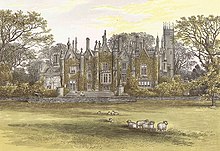
The Park Campus houses the oldest parts of the university's estate, including Singleton Abbey, a large eighteenth-century mansion which was the ancestral home of the Vivian family, having been bought by the prominent industrialist, John Henry Vivian.
Swansea University's foundation stone was laid in 1920 by King George V in July 1920, welcoming 89 students, of whom eight were female.[8] Subjects taught from the beginning of the college were the sciences, mathematics, metallurgy and engineering. The professors were A.R. Richardson (mathematics), E.J. Evans (physics), J.E. Coates (chemistry),[9] A.E. Trueman (geology),[10] C.A. Edwards (metallurgy)[11] and F. Bacon (engineering).
The university was granted a coat of arms by the College of Heralds in 1921 with the motto Gweddw Crefft Heb Ei Dawn, translated as 'technical skill is bereft without culture.'[8]
Arts subjects were not taught immediately in 1920, but started in the following 'session', 1921–22. The first professors in those initial departments were D. Emrys Evans (classics), W.D. Thomas (English language and literature), Henry Lewis (Welsh),[12] E. Ernest Hughes (History),[13] F.A. Cavenagh (education) and Mary Williams (French).[14] Williams was the first woman to be appointed to a chair in the United Kingdom.[14] This met with some reaction from senior men at the college, one of whom she would later marry.
Saunders Lewis, the well-known Welsh language writer and activist, became a member of staff in 1922 although he ran up against controversy in 1936/37 for trying to set fire to a Royal Air Force bombing school on the Llŷn Peninsula. He was tried at the Old Bailey and sent to prison for nine months.[15]
When Singleton Abbey and its surrounding land was handed to the college in 1923, arts subjects were moved there from the college's temporary site in Mount Pleasant. Student numbers remained relatively small until the Second World War.
Swansea acquired departments of philosophy in 1925, German in 1931, economics in 1937, social policy in 1947, political theory and government in 1954 – the same year that a civil engineering and a geography department were added. In 1961 Swansea became a centre for Russian and East European studies, while Italian and Spanish joined the Department of French.
There were many notable staff members at the university in the period, including the long-serving female professor of botany, Florence Mockeridge.[16] Another was Glanmor Williams (history) who retired in 1982.[17] Other well-known staff members were the author of novels such as Lucky Jim and That Uncertain Feeling, Kingsley Amis, who lectured in English in the 1950s and early 1960s;[18] Rush Rhees, who was a member of staff from 1940 to 1966, an expert on philosophy of Ludwig Wittgenstein;[19] and Kenneth O. Morgan (now Lord Morgan of Aberdyfi) who was a junior history lecturer from 1958 to 1966.
Post-war campus development
In 1947, John Fulton, the university principal, had designs on creating the UK's first self-contained university campus. Located in the vast expanse of Singleton Park, the university only had 2 permanent buildings; Singleton Abbey and the library.
The 1960s saw the university embark on a large campus development programme, aiming to fulfill Fulton's plan of becoming a self-contained community within the city. Along with new halls of residence, a Maths and Science Tower was built, with College House – later renamed Fulton House.[8]
Campus
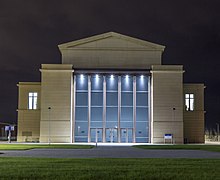
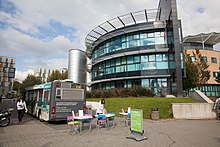
For most of its history, Swansea University operated exclusively from the Singleton Park Campus. However, owing to rapid expansion, the university developed a 65-acre, £450 million beachfront science and innovation Bay Campus which opened in September 2015. Since then, Swansea University has operated as a dual-campus university with the 'Park Campus' located in its traditional Singleton Park grounds, and the Bay Campus, at Crymlyn Burrows.
The Bay campus has been developed on a 65-acre beachfront site between Fabian Way and Jersey Marine beach at Crymlyn Burrows. It houses much of the Faculty of Science and Engineering and the School of Management, a Great Hall seating 800, a library offering views over a Site of Special Scientific Interest, and student accommodation, as well as several research institutes.
Aerial drone 360 views of Swansea university campus contracted by Swansea University in 2023 Aerial Drone 360 view of Swansea Campus and Singleton. Source: Aeroviews
Sports
Swansea Bay Sports Park facilities include, five minutes' walk from the Singleton Park Campus, the 50-metre Wales National Pool Swansea, eight-lane outdoor athletics track, six-lane indoor track and training centre, floodlit playing fields including rugby, football, lacrosse and cricket pitches, artificial hockey pitches, a sports hall, tennis and squash courts, a climbing wall and spin room. Facilities at the Bay Campus include a sports hall, multi-use games area, and gym. The University also owns training pitches in the north of the city, in Fairwood, which it has developed alongside Swansea City A.F.C.[20]
During the 2012 Summer Olympics, the university hosted the training camps for the Mexican and New Zealand paralympic teams and the Ireland triathlon team.[21] In 2014, it hosted the IPC Athletics European Championships. Furthermore, in 2015 it hosted the training camps of the Canada national rugby union team and the Fiji national rugby union team in preparation for the 2015 Rugby World Cup.[22]
Sports science at the university ranks 13th in the Complete University Guide Sports Science Rankings 2023.[23] The department has links with Swansea City A.F.C., Ospreys and Welsh Athletics. Former scholars include Wales rugby union player Alun Wyn Jones, Olympic swimmer Georgia Davies, Paralympian swimmer Liz Johnson and Paralympian boccia player David Smith. Swansea is in the top quarter of the British University's sporting leagues.[24] It competes with Cardiff University in the Welsh Varsity tournament, the largest student sports event in Wales. This includes The Welsh Boat Race and the showcase rugby union varsity match which attracted 16,000 students to Swansea's Liberty Stadium in 2015.[25][26]
Wales National Pool
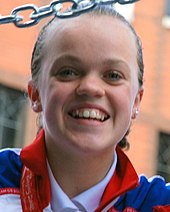
The Wales National Pool, next to the Singleton Park Campus, is a 50-metre pool built to FINA standards. The facility, which also has a 25m × 9.5m training pool and 1,200 spectator seats, is HQ of Swim Wales.
The pool, one of five of British Swimming's Intensive Training Centres (ITC), was used to train swimmers for the London 2012 Olympics was built with funding from Sport Wales, Swansea Council and Swansea University.
It is home to the Swim Wales National Performance Centre,[27] a hub for elite and performance swimming in Wales. This has included disability swimming under renowned coach Billy Pye[28] who has trained several Paralympians in Swansea, including Ellie Simmonds and Liz Johnson.[citation needed] University sports science researchers provide back-up to the hub. The centre is also home to Swansea University Swimming and City of Swansea Aquatics.[citation needed]
Museum of Egyptian Antiquities (The Egypt Centre)
Located in the Taliesin building, the Egypt Centre is open to the public. More than 7,000 items are in its collection.[29] Most were collected by the pharmacist and entrepreneur Sir Henry Wellcome. Others came from the British Museum, the Royal Edinburgh Museum, National Museums and Galleries of Wales Cardiff, the Royal Albert Museum and Art Gallery, and private donors.
Staff lecture museum groups and other outside bodies on volunteering, social inclusion and how to widen community participation with university museums. School parties regularly visit for interactive events.[29]
Organisation and administration
Governance
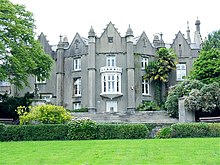
Swansea received its royal charter in 1920 and like many universities is governed by its constitution that is set out in its statutes and a charter. The governing body of Swansea University is its Council, which is supported by the Senate and the Court.
- The Council consists of 29 members including the Chancellor, Pro-chancellors, Vice-chancellor, Treasurer, Pro-vice-chancellors, staff and student members, city council representation and a majority of lay members. The council is responsible for all of the University's activities and has a well-developed committee structure to help discharge its powers and duties.
- The Senate is the main academic body of the university and is responsible for teaching and research. Most of its 200 members are academics but it also includes representatives of the Students' Union and the Athletic Union. The Senate is chaired by the Vice-Chancellor, who is the head of the university both academically and administratively.
- The Court consists of more than 300 members representing stakeholders from local to national institutions. It meets annually to discuss the university's annual report, its financial statements and issues in higher education.
List of vice-chancellors [30]
Principal
- 1920 to 1926: Franklin Sibly; first principal
- 1927 to 1947: C. A. Edwards
- 1947 to 1959: John Fulton
- 1960 to 1965: J. H. Parry
- 1965 to 1974: Frank Llewellyn Jones[31]
- 1974 to 1982: Robert Walter Steel
- 1982 to 1994 Brian Clarkson
Vice-Chancellor
- 1994 to 2003: Robin Williams
- 2003 to 2019: Richard B. Davies
- 2019 onward: Paul Boyle[32]
Faculties and Schools
Swansea University's academic departments are organised into three faculties, which include a total of eleven schools:
Humanities and Social Sciences
School of Culture and Communication
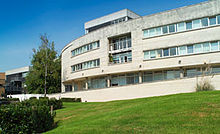
The school offers courses in American studies; classics, ancient history, and Egyptology; English language, teaching English as a second or foreign language, and applied linguistics; English literature and creative writing; film and visual culture; history; media, communications, journalism, and public relations; modern languages, translation, and interpreting; and Welsh.
In spring 2006, M Wynn Thomas and Dai Smith established the Library of Wales series as an offshoot of the school which has influenced Welsh Government policy to benefit the creative industries, cultural tourism and education.[33]
School of Management
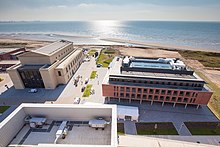
The School of Management is a leading UK provider of management, finance and accounting education, with 100% of its research rated internationally excellent or world-leading in the 2021 Research Excellence Framework.[34]
In 2015, the school relocated to the University's Bay Campus and is home to over 2,000 students, 150 members of staff and a range of industry partners, including The Bevan Commission, Fujitsu, Greenaway Scott, and AgorIP.[35][36][37][38][39]
The School of Management provides a range of undergraduate and postgraduate courses, including accounting and finance, business management, economics, tourism, and marketing.[40] The school ranks in the UK top 30 for business and economics graduate prospects, and top 10 for accounting and finance.[41]
Alongside teaching, the school also houses various research centres including The Centre for Visitor Economy Research (CVER), Emerging Markets Research Centre (EMaRC), The Hawkes Centre for Empirical Finance, Swansea iLab, Welsh Economy Labour Markets Evaluation Research Centre (WELMERC), The Bevan Commission, The Centre for Health and Environmental Management Research and Innovation (CHEMRI), Centre for People and Organisation.[42]
Hillary Rodham Clinton School of Law
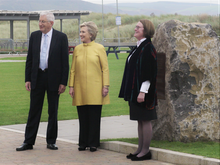
The Hillary Rodham Clinton School of Law is the largest law school in Wales and ranks third in the UK for criminology and 22nd in the UK for law (The Times Good University Guide 2019).[43] Swansea University opened its School of Law in 1994, in order to complement its departments in engineering, the sciences, and arts and humanities. Known previously as the College of Law and Criminology, the school's name changed on 14 October 2017, as part of a ceremony including the conferment of an honorary doctorate on Hillary Clinton.[44]
The school is situated at the Singleton Campus. Plans to move to purpose-built premises on the university's Bay Campus were shelved in the wake of an internal and police investigation into alleged wrongdoing involving the senior staff.[45] This new development was to house commercial law firms, technology companies, national and international agencies, along with the academics and students of the School.
Teaching at the School of Law comprises undergraduate, postgraduate and professional courses.[46] Undergraduate programmes include qualifying law degrees and joint honours programmes. Criminology courses moved to be part of the School of Social Sciences when the move to a Faculty structure took place. Postgraduate law programmes include LLMs in shipping and trade, human rights, legaltech and MA in cyber crime and terrorism and research degrees. Professional courses on offer include LLM law and legal practice (replacing the Graduate Diploma in Law), the Legal Practice Course and related LLM legal practice and advanced drafting, and LLM professional legal practice.[47] Students are taught in lectures, discussion groups and interactive seminars by academics with extensive industry experience.
In the Research Excellence Framework 2021, 87.5% of its research environment was rated internationally excellent and 78% of its research overall was rated as world-leading or internationally excellent. [48] This research encompasses the school's numerous research centres including the Centre for Criminal Justice and Criminology, Cyber Threats Research Centre, The Institute of International Shipping and Trade Law, the Observatory on Human Rights of Children, and the Governance and Human Rights Research Group. [49]
School of Social Sciences
The school offers courses in Criminology; Sociology and Social Policy, Economics, Education and Childhood Studies, and Politics, Philosophy and International Relations.
The School of Social Sciences through its politics course plays a leading role in the Welsh Economy Labour Markets Evaluation Research Centre (WELMERC), established in 2002 to research economic data related to Wales[50]
Medicine, Health and Life Science
Swansea University Medical School

Swansea University Medical School is ranked fourth in the UK according to the Guardian University Guide 2022. [51] In the 2014 and 2021 Research Excellence Framework its research impact was considered outstanding in terms of reach and significance. [52]
Established in 2004, the Medical School works closely with government, industry and the NHS, in particular Abertawe Bro Morgannwg University Health Board, over teaching, research and innovation. It also has two Institute of Life Science research centres, equipped with clinical trials, medical imaging, research and business development facilities and a Centre for NanoHealth.
Its research highlights include DNA damage and the safety of nanomaterials, the control of fungal diseases, children and young people's mental health, avoiding unnecessary medical interventions, and cholesterol in human health and disease. [53]
School of Psychology
School of Health and Social Care
Swansea University's School of Health and Social Care offers courses in health and social care, healthcare science, nursing and midwifery, occupational therapy, osteopathy, operating department practice, paramedic science, and social work. [54]
It ranks fourth in the UK for Health Studies in the Complete University Guide 2023 and in the top ten for Nursing in The Guardian University Guide 2022. [55] Research centres include: the Centre for Global Burns Injury Policy and Research; Centre for Innovative Ageing; Lactation, Infant Feeding and Translational Research; Swansea Centre for Health Economics; Swansea Centre for Improvement and Innovation; Developing Evidence Enriched Practice (DEEP). [56]
Science and Engineering
School of Aerospace, Civil, Electrical, General and Mechanical Engineering
School of Mathematics and Computer Science
The School of Mathematics and Computer Science at Swansea University is located at the state-of-the-art Computational Foundry on the picturesque Bay Campus, which is situated along the beachfront. This £32.5 million facility offers cutting-edge teaching and research amenities, fostering an environment conducive to collaboration with industry partners. It provides a space where new ideas can be tested and where students and researchers can tackle real-world challenges. The school offers highly ranked undergraduate and postgraduate degrees that prepare students for successful careers across various industries or equip them to engage in innovative research. Notably, the Computer Science department has been ranked among the top 200 in the world by the QS World University Rankings 2024.
School of Biosciences, Geography and Physics
School of Engineering and Applied Sciencesedit
Engineering

Engineering has been studied at Swansea University since its beginning in 1920, and the engineering departments are now based in two schools on the Bay Campus - the School of Engineering and Applied Science, and the School of Aerospace, Civil, Electrical, General and Mechanical Engineering.[57]
In the 2021 Research Excellence Framework Engineering at Swansea University rated a 100% world-leading and internationally excellent research environment. [58]
Research centres in the schools include: Zienkiewicz Institute for Modelling, Data and AI; Materials Research Centre (MRC); Systems and Process Engineering Centre (SPEC); Future Manufacturing Research Institute (FMRI); Applied Sports, Technology, Exercise and Medicine Research Centre (A-STEM).
Researchedit
Swansea is a research-led university, ranking 48th in the UK in the 2021 Research Excellence Framework (REF).[59] The university submitted the work of a record number of researchers (578) for assessment to REF2021, a 56% increase on the 370 submitted in 2014. It meant a growth in the university's overall proportion of world-leading and internationally excellent research from 80% in 2014 to 86% in 2021. Almost a third (32%) of its outputs were rated 4* world-leading (up from 21% in 2014), and 91% of its research environment is rated 4* world-leading or 3* internationally excellent, with 86% of its research judged outstanding and very considerable in terms of impact - reach and significance.[60]
Medicine and Life Science continue to be ranked in the UK top five overall at 4th in Allied Health Professions (UOA3), and Mathematics is ranked joint 16th in the UK and is joint top for impact, with 100% rated as outstanding. Geography is ranked 20th in the UK, climbing 11 places with 90% 4* world-leading or 3* internationally excellent research. A third of the university's units of assessment rated 100% for their outstanding and very considerable impact.[61]
Selected research centres and institutesedit

- Centre for Nanohealth
- Research Institute for Arts and Humanities – which includes the Global Drug Policy Observatory
- Institute of Life Sciences
- Research Institute for Applied Social Sciences
- Welsh Institute of Cognitive Neuroscience
- SPECIFIC
- CSAR
- Energy Safety Research Institute (ESRI)
Academic profileedit
Rankings and reputationedit
| National rankings | |
|---|---|
| Complete (2025)[62] | 39 |
| Guardian (2024)[63] | 25 |
| Times / Sunday Times (2024)[64] | 41 |
| Global rankings | |
| ARWU (2023)[65] | 401–500 |
| QS (2025)[66] | 298= |
| THE (2024)[67] | 251–300 |
The university is listed as one of the top 500 universities in the World University Rankings.[68][69] Swansea is ranked 26th in the Guardian 2024 University guide.[70]
Swansea University's best ranked departments include Medicine and Mathematics, ranked 4th and 16th respectively in the 2021 Research Excellence Framework. The Law Department also ranks highly, coming in at 22nd in the Times Good University Guide 2019 in the UK, as well as in the 151–200 category in QS World Rankings.[71] Overall, Swansea University is ranked 48th in the 2021 Research Excellence Framework.[72]
National Student Survey results (for 2021) rank Swansea 12th in the UK for "overall satisfaction", with 82% saying they are satisfied with their course overall.[73] The survey ranked Swansea number one for Archaeology; Biology (non-specific); English Language; and Others in Business and Management.
Swansea University is top in Wales in the 2023 Guardian University Guide [74] and in the 2022 Student Crowd university rankings, which places it 15th in the UK.[75]
International partnershipsedit
In recent years, Swansea University has established many partnerships with leading universities in Europe, North America, Africa and Asia.
Swansea University has a strategic partnership with Wuhan Union Hospital in Wuhan, China.[76] The hospital was founded by Swansea missionary Reverend Doctor Griffith John. As a result of this partnership, in 2015, the College of Medicine hosted the 2nd UK-China Medical Forum at Singleton Hospital. Swansea University has also established a joint medical centre at the Wuhan Union Hospital to engage in clinical collaboration. In 2020, the partnership enabled health experts from across Wales to learn from some of the first medics to tackle the COVID-19 pandemic.[77]
Zdroj:https://en.wikipedia.org?pojem=Swansea_University
Text je dostupný za podmienok Creative Commons Attribution/Share-Alike License 3.0 Unported; prípadne za ďalších podmienok. Podrobnejšie informácie nájdete na stránke Podmienky použitia.
Antropológia
Aplikované vedy
Bibliometria
Dejiny vedy
Encyklopédie
Filozofia vedy
Forenzné vedy
Humanitné vedy
Knižničná veda
Kryogenika
Kryptológia
Kulturológia
Literárna veda
Medzidisciplinárne oblasti
Metódy kvantitatívnej analýzy
Metavedy
Metodika
Text je dostupný za podmienok Creative
Commons Attribution/Share-Alike License 3.0 Unported; prípadne za ďalších
podmienok.
Podrobnejšie informácie nájdete na stránke Podmienky
použitia.
www.astronomia.sk | www.biologia.sk | www.botanika.sk | www.dejiny.sk | www.economy.sk | www.elektrotechnika.sk | www.estetika.sk | www.farmakologia.sk | www.filozofia.sk | Fyzika | www.futurologia.sk | www.genetika.sk | www.chemia.sk | www.lingvistika.sk | www.politologia.sk | www.psychologia.sk | www.sexuologia.sk | www.sociologia.sk | www.veda.sk I www.zoologia.sk
